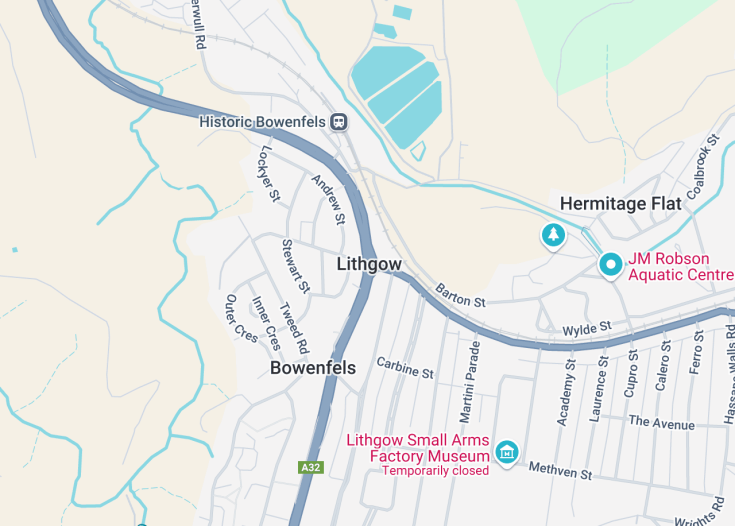Nestled in the scenic vistas of the Blue Mountains, Lithgow is a charming destination rich with colonial heritage and natural beauty. Known for its pivotal role in Australia’s industrial history, this town offers a unique mix of cultural museums, historical sites, and outdoor adventures.
The Zig Zag Railway and the hauntingly beautiful Glow Worm Tunnel offer captivating experiences. Additionally, Lithgow’s proximity to national parks makes it a haven for nature enthusiasts and trekkers alike.
Explore Lithgow during the cooler months to fully enjoy its outdoor attractions without the summer heat impacting your experience.
Don’t miss a visit to the Lithgow Small Arms Factory Museum, a key site that delves into the intriguing industrial past of the region.
Top things to do & see in Lithgow
Select the following sights and activities to discover best tickets and tours available in Lithgow.
Lithgow: A Heritage Gateway
| Country | Australia |
| Time in Lithgow | GMT+10 |
| Language spoken | English |
| Population | 13,090 (Source: Australian Bureau of Statistics) |
| Currency | Australian Dollar (AUD $) |
| Airports |
|
Lithgow, Australia, located in the shadow of the Blue Mountains, is a mix of natural beauty and rich industrial history. This quaint town, established in the mid-19th century, quickly became a central point for the Western coalfields in New South Wales.
Historical sites such as the Zig Zag Railway and the Eskbank House Museum allow visitors to step back in time and experience Australia’s industrial revolution. Lithgow is also known for its scenic landscapes, including the nearby Wollemi National Park and Lake Lyell, offering opportunities for outdoor activities such as hiking, fishing, and camping.
Where is Lithgow?
Lithgow is nestled in a small valley within the Central Tablelands of New South Wales, Australia, benefiting from both mountainous terrains and expansive open spaces.
Distances:
Road Routes from Major Cities:
| Route | Distance by car | Time by car |
|---|---|---|
| Sydney to Lithgow | 95 miles (153 km) | 2 hours |
| Canberra to Lithgow | 149 miles (240 km) | 3 hours, 20 min |
| Newcastle to Lithgow | 139 miles (224 km) | 3 hours, 10 min |
What is Lithgow famous for?
Lithgow is renowned for its significant role in Australia’s coal industry. The town is also famous for its historical railway, the presence of various heritage sites, and natural reserves that attract nature enthusiasts and history buffs alike.
History
Pre-1800s: Indigenous Heritage
The area now known as Lithgow was originally inhabited by the Wiradjuri people, one of the largest Indigenous groups in central New South Wales. They lived a nomadic lifestyle that was intricately connected to the land, with a culture rich in spiritual and community practices. The region’s plentiful natural resources supported their way of life for thousands of years before European settlement.
1800s: European Settlement and Industrialization
European exploration of the Lithgow Valley commenced in the early 19th century. The first European settler, Andrew Brown, recognized the region’s potential for agriculture and grazing. However, it was the discovery of coal in the mid-1800s that transformed Lithgow into an industrial hub. The establishment of ironworks and the expansion of coal mining activities attracted a diverse workforce and spurred economic growth. Lithgow also played a pivotal role in the development of the Western railway, which further facilitated industrial and urban development.
1900s: Economic Shifts and Heritage Preservation
Throughout the 20th century, Lithgow continued to evolve. The decline of heavy industry in the latter half led to economic challenges, but the community adapted by embracing its rich heritage. The establishment of various museums and historical sites helped Lithgow transition into a centre for tourism and cultural heritage, preserving its unique industrial history for future generations.
2000s-Present: Tourism and Contemporary Development
In recent years, Lithgow has embraced its historical and natural heritage, promoting itself as a tourism destination. Efforts have been made to balance development with environmental and historical preservation, ensuring that Lithgow remains a vibrant community with a strong sense of its past while looking forward to new opportunities in tourism and regional development.
Visit Lithgow
What to see and do in Lithgow, Australia
Explore the Lithgow’s rich history at the Lithgow State Mine Heritage Park and Museum, which offers insights into the coal mining history. For nature enthusiasts, the nearby Blue Mountains provide stunning scenery and numerous walking trails.
Don’t miss visiting the Glow Worm Tunnel for a unique wildlife experience. Additionally, the Lithgow Small Arms Factory Museum showcases the region’s industrial prowess in arms manufacturing.
- Lithgow State Mine Heritage Park and Museum
- Exploring the Blue Mountains
- Visit the Glow Worm Tunnel
- Lithgow Small Arms Factory Museum
Events in Lithgow
Lithgow hosts several cultural and community events throughout the year. The Lithgow Halloween Festival, held in October, transforms the town with festivities that include street parades, live music, and themed displays.
In addition, the Ironfest, an annual cultural festival in April, celebrates arts, history, and heritage with a variety of performances and exhibitions.
Best time to visit Lithgow
The ideal time to visit Lithgow is during the spring (September to November) and autumn (March to May) months. These seasons offer pleasant weather, perfect for exploring the outdoor attractions and participating in the local festivals.
Is Lithgow worth visiting?
Lithgow offers a unique blend of historical attractions and natural beauty, making it an interesting destination for travelers. The rich industrial history is well-preserved in local museums and heritage parks, appealing to history enthusiasts.
The proximity to the Blue Mountains also caters to nature lovers. However, those seeking urban entertainment or extensive nightlife may find the offerings limited. Overall, if you appreciate outdoor activities and historical exploration, Lithgow will not disappoint.









